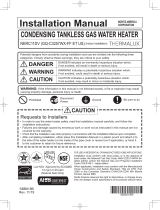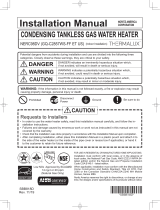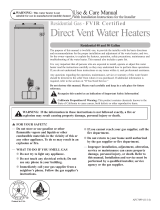6
SECTION III: GENERAL INFORMATION
This water heater contains the following features:
Main Power On/Off Switch
The front panel of this water heater has a lighted ON/OFF switch, which is illuminated when the main power is turned on
to indicate power to the water heater.
Combustion System
This water heater is equipped with a self-compensating negative pressure pre-mix combustion system. As the blower
operates, air is drawn in through the air intake and into a venturi, which pulls gas from the gas valve. The gas and air are
then mixed in the combustion blower and sent through the transition tube into the burner. The Direct Spark Ignition
System (DSI) then ignites the gas/air fuel mixture to produce flue products (combustion). The flame sensor signals the
ignition control board (described below), that a flame is present.
ICON System Control
Consists of a control board and a water heater display. An attractive digital water heater display is on the top front of the
water heater for precisely setting and displaying the temperature setpoint and monitoring the status of the water heater.
Pressing the temperature UP and DOWN buttons changes the temperature setpoint. The temperature format may be
displayed in degrees F or degrees C. The water heater display will show diagnostic codes in the event the water heater
needs servicing. The temperature readings of the tank sensor can be monitored in Service Mode. In Service Mode, the
display can also show up to 10 previous error codes to further aid in servicing the water heater.
The single control board has plug in wiring harnesses to reduce the chance of mis-wiring. The control board controls all
ignition, temperature, and combustion blower functions. The control board controls the combustion blower, ignition
timings, and gas valve to control the combustion system in order to maintain the desired tank temperature.
Adjustable Thermostat
This water heater is equipped with an adjustable thermostat as part of the Integrated Control System to control water
temperature. Hot water temperatures required for automatic dishwasher and laundry use can cause scald burns resulting
in serious personal injury and/or death.
The temperature may be adjusted from about 70°F (21°C) to about 180°F (82°C). The thermostat was adjusted to 70°F
(21°C) before the water heater was shipped from the factory. It is recommended that lower temperatures be used to
avoid the risk of scalding. Refer to the warnings and the section on Scalding in Section V: Water Connections (page 15). It
is further recommended, in all cases, that the water temperature be set for the lowest temperature, which satisfies your
hot water requirements for the installation. This will also provide the most energy efficient operation of the water heater
and minimizes scale formation.
Setting the water heater temperature at 120°F (49°C) will reduce the risk of scalds. Some states require setting lower
temperatures for specific installations.
The top immersion well of the single sensor control also contains a redundant sensor for the high limit (energy cutoff).
The high limit circuit interrupts the main burner gas flow should the water temperature exceed approximately 207°F
(97.2°C). Error code 80 will be shown on the water heater control display if the high limit temperature has been exceeded.
Should the high limit switch activate, it must be manually reset. This should only be done by a service technician after the
cause of overheating has been corrected. Refer to the section on Accessing Service Mode on the Display in the
Diagnostic section (page 53).
Contact your qualified installing contractor, service provider or manufacturer listed on the rating plate if continued high
limit operation occurs.
Service Panel
The service panel is located behind the service panel access cover, which is located by the exhaust elbow near the
bottom of the water heater. This panel contains a pressure switch that monitors the pressure in the exhaust pipe in case
the vent terminal becomes blocked. A collector high limit switch is used to monitor the ambient temperature between the
first pass collector and the exhaust collector. This is a manually re-settable switch. If this switch continues to trip, please
contact an authorized service agency.
Latches
The latches allow easy access for servicing the water heater from the top. Simply remove the two latches for servicing
and re-latch upon completion. No tools are required to obtain access to the top of the water heater.






















